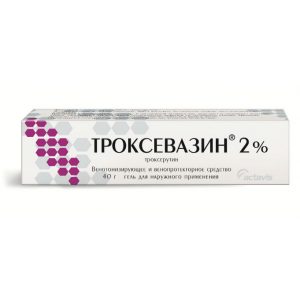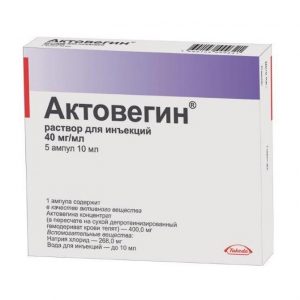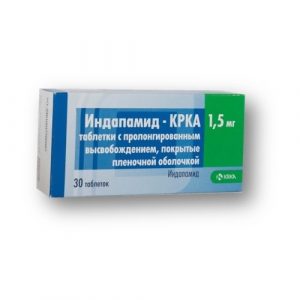Description
Release form
Film-coated tablets
Packing
100pcs
Pharmacological action
Reduces aggregation, platelet adhesion and thrombosis by inhibiting the synthesis of thromboxane A2 in platelets. The antiplatelet effect persists for 7 days after a single dose (more pronounced in men than in women).
Acetylsalicylic acid reduces mortality and the risk of developing myocardial infarction with unstable angina, is effective in the primary prevention of diseases of the cardiovascular system, especially myocardial infarction in men over 40, and in the secondary prevention of myocardial infarction.
Suppresses the synthesis of prothrombin in the liver and increases prothrombin time. It increases the fibrinolytic activity of blood plasma and reduces the concentration of vitamin K-dependent coagulation factors (II, VII, IX, X). Increases the risk of hemorrhagic complications during surgical interventions, increases the risk of bleeding during anticoagulant therapy.
Acetylsalicylic acid in high doses also has an anti-inflammatory, analgesic, antipyretic effect.
In high doses, acetylsalicylic acid stimulates the excretion of uric acid (disrupts its reabsorption in the renal tubules).
Blockade of cyclooxygenase-1 in the gastric mucosa leads to inhibition of gastroprotective prostaglandins, which can lead to ulceration of the mucous membrane and subsequent bleeding.
Magnesium hydroxide, which is part of the drug Thrombital Forte, protects the mucous membrane of the gastrointestinal tract from exposure to acetylsalicylic acid.
Indications
Primary prophylaxis of cardiovascular diseases such as thrombosis and acute heart failure in the presence of risk factors (eg, diabetes mellitus, hyperlipidemia, hypertension, obesity, smoking, old age).
Prevention of cardiovascular disease: recurrent myocardial infarction, blood vessel thrombosis.
Prevention of thromboembolism after vascular surgery (e.g., coronary artery bypass grafting, percutaneous transluminal coronary angioplasty, etc.).
Unstable angina pectoris (including suspected acute myocardial infarction).
Contraindications
Hypersensitivity to acetylsalicylic acid, excipients and other non-steroidal anti-inflammatory drugs (NSAIDs)
cerebral hemorrhage
tendency to bleed (vitamin K deficiency, thrombosis, gastrointestinal disease) in the acute phase)
gastrointestinal bleeding
bronchial asthma, a combination of bronchial asthma, recurring nasal polyposis and paranasal sinuses with intolerance to acetylsalicylic acid
induced by the administration of salicylates and other NSAIDs
simultaneous administration of methotrexate at a dose of 15 mg per week or more
pregnancy (I and III trimester lactosephritis srdl srd
phosphate dehydrogenase severe renal failure (creatinine clearance (CC) less than 30 ml / min)
severe liver failure (Child-Pugh class B and C)
chronic heart failure III and IV fu tional class classification NYHA
Children up to age 18 years.
Precautions:
For gout, hyperuricemia, since acetylsalicylic acid in small doses reduces uric acid excretion.
If there is a history of ulcerative lesions of the gastrointestinal tract or gastrointestinal bleeding.
With liver failure (class A on the Child-Pugh scale).
In renal failure (CC more than 30 ml / min).
For bronchial asthma, chronic respiratory diseases, hay fever, nasal polyposis, allergic conditions, drug allergies.
With diabetes.
In elderly patients.
In the second trimester of pregnancy.
With the proposed surgical intervention (including minor ones, for example, tooth extraction), as acetylsalicylic acid may cause a tendency to develop bleeding within a few days after taking the drug.
When taken concomitantly with the following medicines (see Section Interaction with other drugs):
with methotrexate at a dose of less than 15 mg per week
with anticoagulants, thrombolytic or antiplatelet agents
with NSAIDs and salicylic acid derivatives in high doses
with digoxin
with hypoglycemic drugs (for administration of hypoglycemic drugs) and insulin
with valproic acid
with alcohol (alcoholic beverages in particular)
with selective serotonin reuptake inhibitors
with ibuprofen,
with narcotic ana analgesics,
with sulfonamides (including co-trimoxazole),
with carbonic anhydrase inhibitors (acetazolamide),
with lithium,
with systemic glucocorticosteroids.
Special instructions
The drug should be used as directed by a doctor.
Trombital Forte tablets are film-coated, have no risks and are not intended for division, so if your doctor recommends lowering the daily dose of acetylsalicylic acid to 75 mg, then you need to switch to taking another drug, containing 75 mg of acetylsalicylic acid in 1 tablet.
Acetylsalicylic acid can provoke bronchospasm, as well as cause attacks of bronchial asthma and other hypersensitivity reactions. Risk factors are a history of bronchial asthma, hay fever, nasal polyposis, chronic diseases of the respiratory system, as well as allergic reactions to other drugs (for example, skin reactions, itching, urticaria).
Acetylsalicylic acid can cause bleeding of varying severity during and after surgical interventions. A few days before the planned surgical intervention, the risk of bleeding should be assessed compared with the risk of developing ischemic complications in patients taking low doses of acetylsalicylic acid.
If the risk of bleeding is significant, acetylsalicylic acid should be temporarily discontinued. The combination of acetylsalicylic acid with anticoagulants, thrombolytics and antiplatelet drugs is associated with an increased risk of bleeding.
Acetylsalicylic acid in low doses can trigger the development of gout in susceptible patients (with decreased uric acid excretion). The combination of acetylsalicylic acid with methotrexate is accompanied by an increased incidence of side effects from the blood forming organs.
High doses of acetylsalicylic acid have a hypoglycemic effect, which must be borne in mind when prescribing it to patients with diabetes mellitus receiving hypoglycemic agents for oral administration and insulin.
With the combined use of systemic glucocorticosteroids and salicylates, remember that during treatment, the concentration of salicylates in the blood is reduced, and after the abolition of systemic glucocorticosteroids, an overdose of salicylates is possible.
The combination of acetylsalicylic acid with ibuprofen is not recommended in patients with an increased risk of cardiovascular disease: with simultaneous use with ibuprofen, a decrease in the antiplatelet effect of acetylsalicylic acid in doses up to 300 mg is observed, which leads to a decrease in the cardioprotective effects of acetylsalicylic acid.
An increase in the dose of acetylsalicylic acid over therapeutic doses is associated with a risk of gastrointestinal bleeding.
With prolonged use of low doses of acetylsalicylic acid as antiplatelet therapy, caution should be exercised in elderly patients due to the risk of gastrointestinal bleeding.
While taking acetylsalicylic acid with alcohol, the risk of damaging the mucous membrane of the gastrointestinal tract and prolonging bleeding time is increased.
With prolonged use of the drug, a general blood test and fecal occult blood test should be done periodically.
During treatment with acetylsalicylic acid preparations, care must be taken when driving vehicles and engaging in potentially hazardous activities that require increased concentration of attention and speed of psychomotor reactions.
Composition
Active ingredients:
acetylsalicylic acid – 150.00 mg,
magnesium hydroxide – 30.39 mg.
Excipients:
microcrystalline cellulose – 24.15 mg,
corn starch – 19.00 mg,
potato starch – 4.00 mg,
magnesium stearate – 0.30 mg.
Shell:
hypromellose (hydroxypropyl methylcellulose 15 cPs) – 1.20 mg,
macrogol (polyglycol 4000) – 0.24 mg,
talc – 0.72 mg.
Dosage and administration
The drug is taken orally with water. The tablet can be swallowed whole, chewed or pre-ground.
The drug is intended for prolonged use. The duration of treatment with Trombital Forte is determined by the doctor. 1 tablet of Thrombital Forte contains 150 mg of acetylsalicylic acid. If necessary, according to the doctor s decision, it is possible to reduce the daily dose of acetylsalicylic acid to 75 mg (see section Special Instructions). Primary prevention of cardiovascular diseases such as thrombosis and acute heart failure in the presence of risk factors (e.g., diabetes mellitus, hyperlipidemia, hypertension, obesity, smoking, advanced age) – 1 tablet 1 time per day.
Prevention of cardiovascular disease: repeated myocardial infarction, blood vessel thrombosis – 1 tablet 1 time per day.
Prevention of thromboembolism after vascular surgery (for example, coronary artery bypass grafting, percutaneous transluminal coronary angioplasty, etc.) – 1 tablet once a day.
Unstable angina (including suspected development of acute myocardial infarction) – 1 tablet once a day.
In case of unstable angina pectoris with suspected development of acute myocardial infarction, the first tablet must be chewed for faster absorption.
Use the drug only according to the indications, the method of use and at the doses indicated in the instructions.
Side effects
The following adverse events are distributed according to the frequency of occurrence according to the following gradation: very often (with a frequency of more than 1/10), often (with a frequency of at least 1/100, but less than 1/10), infrequently (with with a frequency of at least 1/1000, but less than 1/100), rarely (with a frequency of at least 1/10000, but less than 1/1000), very rarely (with a frequency of less than 1/10000), including individual messages.
On the part of the blood and lymphatic system: very often – increased bleeding (hematomas, nosebleeds, bleeding gums, bleeding from the genitourinary tract) rarely – anemia very rarely – hypoprothrombinemia, thrombocytopenia, neutropenia, aplastic anemia, eosinophilia, agranulocytosis unknown.
There are reports of serious cases of bleeding, which include gastrointestinal bleeding and cerebral hemorrhage (especially in patients with arterial hypertension who have not reached the target blood pressure figures and / or receive concomitant therapy with anticoagulant drugs), which in some cases can be life-threatening. Bleeding can lead to the development of acute or chronic posthemorrhagic / iron deficiency anemia (for example, due to occult bleeding) with the corresponding clinical and laboratory signs and symptoms (asthenia, pallor, hypoperfusion). There are reports of cases of hemolysis and hemolytic anemia in patients with severe glucose-6-phosphate dehydrogenase deficiency.
Allergic reactions: often – urticaria, Quincke’s edema infrequently – anaphylactic reactions, including angioedema, unknown frequency – skin rash, itching, rhinitis, swelling of the nasal mucosa, cardio-respiratory distress syndrome, as well as severe reactions, including anaphylactic shock.
From the side of the nervous system: often – headache, insomnia infrequently – dizziness, drowsiness rarely – tinnitus, intracerebral hemorrhage unknown frequency – hearing loss, which may be a sign of an overdose of the drug (see section Overdose).
From the respiratory system, chest and mediastinal organs: often – bronchospasm.
From the gastrointestinal tract: very often – heartburn often – nausea, vomiting infrequently – pain in the abdomen, ulcers of the mucous membrane of the stomach and duodenum, including perforated (rarely), gastrointestinal bleeding is rare – increased activity of liver enzymes is very rare – stomatitis, esophagitis, erosive lesions of the upper gastrointestinal tract, stricture, irritable bowel syndrome, colitis unknown frequency – decreased appetite, diarrhea.
From the urinary system: unknown frequency – impaired renal function and acute renal failure.
If you have any side effects that are indicated in the instructions, or they are exacerbated, or you notice any other side effects that are not listed in the instructions, inform your doctor.
Drug interaction
With the simultaneous use of acetylsalicylic acid enhances the action of the following drugs:
methotrexate by reducing renal clearance and displacing it from protein, the combination of acetylsalicylic acid with methotrexate is accompanied by an increased incidence of side effects of narcotics other NSAIDs
heparin and indirect anticoagulants due to impaired platelet function and displacement of indirect anticoagulants due to blood plasma proteins
thrombolytic, antiplatelet and anticoagulant drugs (ticlopidine)
digoxin excrement for its reduction by taking insulin due to the hypoglycemic properties of acetylsalicylic acid itself in high doses and displacement of sulfonylurea derivatives from protein binding LASMA blood
valproic acid due to displacement from its connection with blood plasma proteins. The simultaneous use of acetylsalicylic acid with ibuprofen leads to a decrease in the cardioprotective effects of acetylsalicylic acid.
Combination of acetylsalicylic acid with anticoagulants, thrombolytics and antiplatelet agents are associated with an increased risk of bleeding. Simultaneous administration with acetylsalicylic acid increases the concentration of barbiturates and lithium salts in blood plasma.
Strengthening the elimination of salicylates, systemic glucocorticosteroids weaken their effect.
Glucocorticosteroids, ethanol and ethanol-containing drugs increase the negative effect on the mucous membrane of the gastrointestinal tract and increase the risk of gastrointestinal bleeding.
With the simultaneous administration of acetylsalicylic acid with ethanol, an increase in the toxic effect of ethanol on the central nervous system is observed.
Acetylsalicylic acid weakens the effect of uricosuric drugs – benzbromarone, probenicide (decrease in uricosuric effect, due to competitive suppression of renal tubular excretion by uric acid), angiotensin-converting enzyme inhibitors (there is a dose-dependent decrease in glomerular filtration rate due to inhibition of prostaglandins with a vasodilating effect, and, accordingly, a decrease in hypotensive effect), diuretics (when used together with acetylsalicylic acid a decrease in glomerular filtration rate as a result of a decrease in the synthesis of prostaglandins in the kidneys). Antacids and colestyramine reduce the absorption of acetylsalicylic acid.
Overdose
May occur after a single large dose or with prolonged use of the drug. If a single dose of acetylsalicylic acid is less than 150 mg / kg, acute poisoning is considered mild, 150-300 mg / kg is of moderate severity, and higher doses are considered severe.
Symptoms of overdose of mild to moderate severity: dizziness, tinnitus, hearing impairment, visual impairment, sweating, nausea, vomiting, headache, confusion, tachypnea, hyperventilation, respiratory alkaloid.
Treatment: vomiting provocation, repeated administration of activated carbon, forced alkaline diuresis, restoration of water-electrolyte balance and acid-base state.
Medium to severe overdose symptoms:
respiratory alkalosis with compensatory metabolic acidosis
hyperpyrrhosis (extremely high body temperature)
respiratory disorders: hyperventilation, non-cardiogenic asthma , decrease in blood pressure, inhibition of cardiac activity, collapse of
impaired water-electrolyte balance: dehydration, impaired renal function from oliguria up to the development I kidney failure characterized by hypokalemia, hypernatremia, hyponatremia
impaired glucose metabolism: hyperglycemia, hypoglycemia (especially in children), ketoacidosis
tinnitus
gastrointestinal bleeder drowsiness, confusion, coma, convulsions).
Treatment: immediate hospitalization in specialized wards for emergency therapy – gastric lavage, repeated administration of activated charcoal and laxatives, urination of the urine (shown at salicylate level above 500 mg / l, provided by intravenous infusion of hydrocarbon 5% sodium hydroxide) glucose, at a rate of 10-15 ml / kg / h), restoration of circulating blood volume and induction of diuresis (achieved by administration of sodium bicarbonate in the same dose and dilution, repeated 2-3 times) should be borne in mind that intensive fluid infusion in elderly patients can lead to pulmonary edema.
Acetozolamide is not recommended for alkaline urination (may cause acidemia and enhance the toxic effect of salicylates). When carrying out alkaline diuresis, it is necessary to achieve pH values between 7.5 and 8. Hemodialysis is indicated in blood plasma salicylate levels above 1000 mg / l, and in patients with chronic poisoning – 500 mg / l and below in the presence of indications (refractive acidosis, progressing worsening of the condition, severe defeat of the central nervous system, pulmonary edema and renal failure).
At pulmonary edema artificial ventilation with oxygen-enriched mixture is shown, in the mode of positive pressure at the end of exhalation hyperventilation and osmotic diuresis are used to treat brain edema. The greatest risk of developing chronic intoxication is observed in the elderly when taken for several days more than 100 mg / kg / day.
In children and elderly patients, the initial signs of salicylicism (nausea, vomiting, tinnitus, impaired vision, dizziness, headache, general malaise) are not always noticeable, so it is advisable to periodically determine the content of salicylates in blood plasma.
Storage Conditions
At a temperature not exceeding 25 ° C.
Shelf life
2 years.
Deystvuyushtee substance
Atsetilsalitsilovaya Chisloth [Magna gidroksid]
Terms and conditions
without prescription
Formulation
tablets
Prescribing
Prescribing
Adults by doctor’s prescription




